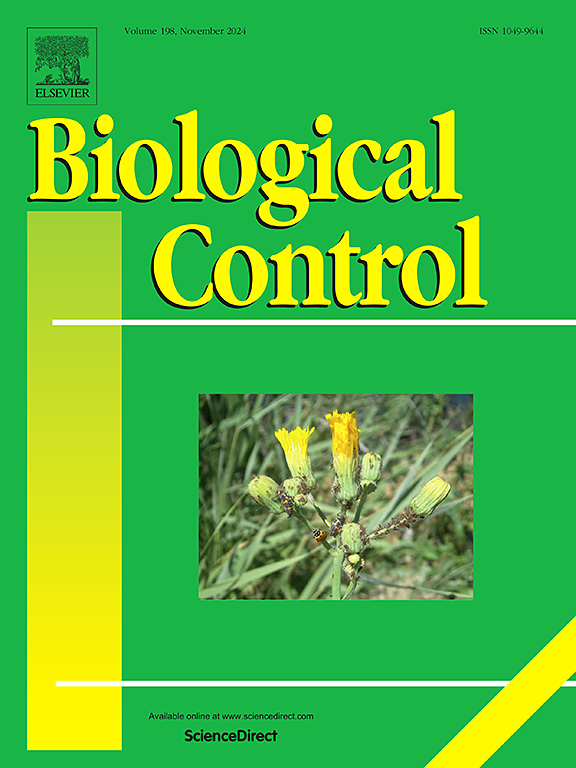结合根际土壤微生物群和代谢组学,揭示长期施用生物有机肥抑制烟草疫霉的机制
IF 3.4
2区 农林科学
Q2 BIOTECHNOLOGY & APPLIED MICROBIOLOGY
引用次数: 0
摘要
合理施用生物有机肥对减少化肥施用、减轻环境污染风险、促进植物健康具有重要优势。然而,根际土壤微生物群落、相关代谢物和抑制病原菌机制之间的相互作用是必要的,特别是在长期施用生物有机肥时。因此,我们的研究包括三个试验条件:常规化肥施用(CF)、减少20%化肥配以有机肥(OF)和减少20%化肥配以生物有机肥(BOF)。通过微生物学和代谢组学的结合,研究了长期不同施肥措施对根际土壤微生物群落和代谢功能的影响。与CF相比,BOF处理显著降低了根际土壤中烟草疫霉的相对丰度和相应病害。硝态氮、全氮、速效磷、有机质和脲酶活性均显著升高。同时,门水平的变形菌门的相对丰度显著增加,属水平的双胞菌门和鞘单胞菌门的相对丰度显著增加。此外,BOF影响了土壤细菌共生网络的复杂性和稳定性。此外,代谢物谱也发生了显著改变,BOF处理显著增加了KEGG代谢途径中的差异代谢物,特别是与赤霉素次级代谢物、组氨酸和色氨酸代谢相关的途径。相关分析和结构方程建模表明,土壤性质、微生物和代谢物之间存在显著的交互作用,这些交互作用都对病害的发生有重要影响。因此,我们观察到土壤肥力、根际微生物和色氨酸代谢物共同促进了作物健康对生物有机替代品部分替代化肥的有利反应。这些发现为减少化肥和环境污染的可持续实践提供了新的见解。本文章由计算机程序翻译,如有差异,请以英文原文为准。

Integrated the rhizosphere soil microbiota and metabolome reveal mechanisms inhibiting Phytophthora nicotianae under long-term bio-organic fertilizer application
Rational bio-organic fertilizer application has important advantages in reducing chemical fertilizer application, mitigating environmental pollution risks and enhancing plant health. However, the interplay between rhizosphere soil microbial communities, associated metabolites and the inhibiting pathogenic bacteria mechanisms is required, particularly in the long-term bio-organic fertilizer application. Therefore, our study encompassed three experimental conditions: conventional chemical fertilizer application (CF), 20 % reduction in chemical fertilizer supplemented with organic fertilizer (OF) and 20 % chemical fertilizer reduction supplemented with bio-organic fertilizer (BOF). By integrating microbiology and metabonomics, we aimed to elucidate the effects of long-term different fertilizer measures on the rhizosphere soil microbial community and metabolic function. Compared with CF, the relative abundance of Phytophthora nicotianae in rhizosphere soil and corresponding disease significantly decreased with BOF. However, there were significant increases in the concentrations of nitrate nitrogen, total nitrogen, available phosphorus, organic matter and urease activity. Simultaneously, the relative abundance of Proteobacteria at the phylum level notably increased with BOF, whereas the relative abundance of Gemmatimonas and Sphingomonas at the genus level exhibited significant increases. Moreover, the BOF affected the complexity and stability of the soil bacterial symbiotic networks. Furthermore, the metabolite profiles were significantly altered, with the differential metabolites in KEGG metabolic pathways being notably enriched for BOF treatment, particularly in pathways related to gibberellin secondary metabolite, histidine, and tryptophan metabolism. The correlation analysis and structural equation modeling revealed significant interactions between soil properties, microorganisms and metabolites, all of which had a substantial impact on the disease incidence. Consequently, we observed that soil fertility, rhizosphere microorganisms and tryptophan metabolites collectively facilitated the favorable response of crop health to the partial replacement of chemical fertilizers with bio-organic alternatives. These findings provided novel insights into sustainable practices of the reduction of chemical fertilizer and environmental pollution.
求助全文
通过发布文献求助,成功后即可免费获取论文全文。
去求助
来源期刊

Biological Control
生物-昆虫学
CiteScore
7.40
自引率
7.10%
发文量
220
审稿时长
63 days
期刊介绍:
Biological control is an environmentally sound and effective means of reducing or mitigating pests and pest effects through the use of natural enemies. The aim of Biological Control is to promote this science and technology through publication of original research articles and reviews of research and theory. The journal devotes a section to reports on biotechnologies dealing with the elucidation and use of genes or gene products for the enhancement of biological control agents.
The journal encompasses biological control of viral, microbial, nematode, insect, mite, weed, and vertebrate pests in agriculture, aquatic, forest, natural resource, stored product, and urban environments. Biological control of arthropod pests of human and domestic animals is also included. Ecological, molecular, and biotechnological approaches to the understanding of biological control are welcome.
 求助内容:
求助内容: 应助结果提醒方式:
应助结果提醒方式:


